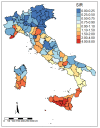Spatio-Temporal Pattern and Meteo-Climatic Determinants of Visceral Leishmaniasis in Italy
- PMID: 36355879
- PMCID: PMC9694427
- DOI: 10.3390/tropicalmed7110337
Spatio-Temporal Pattern and Meteo-Climatic Determinants of Visceral Leishmaniasis in Italy
Abstract
Historically, visceral leishmaniasis (VL) in Italy was constrained to Mediterranean areas. However, in the last 20 years, sand fly vectors and human cases of VL have been detected in northern Italy, traditionally classified as a cold area unsuitable for sand fly survival. We aim to study the spatio-temporal pattern and climatic determinants of VL incidence in Italy. National Hospital Discharge Register records were used to identify incident cases of VL between 2009 and 2016. Incident rates were computed for each year (N = 8) and for each province (N = 110). Data on mean temperature and cumulative precipitation were obtained from the ERA5-Land re-analysis. Age- and sex-standardized incidence rates were modeled with Bayesian spatial and spatio-temporal conditional autoregressive Poisson models in relation to the meteo-climatic parameters. Statistical inference was based on Monte Carlo−Markov chains. We identified 1123 VL cases (incidence rate: 2.4 cases/1,000,000 person-years). The highest incidence rates were observed in southern Italy, even though some areas of northern Italy experienced high incidence rates. Overall, in the spatial analysis, VL incidence rates were positively associated with average air temperatures (β for 1 °C increase in average mean average temperature: 0.14; 95% credible intervals (CrI): 0.01, 0.27) and inversely associated with average precipitation (β for 20 mm increase in average summer cumulative precipitation: −0.28, 95% CrI: −0.42, −0.13). In the spatio-temporal analysis, no association between VL cases and season-year specific temperature and precipitation anomalies was detected. Our findings indicate that VL is endemic in the whole Italian peninsula and that climatic factors, such as air temperature and precipitation, might play a relevant role in shaping the geographical distribution of VL cases. These results support that climate change might affect leishmaniasis distribution in the future.
Keywords: environmental epidemiology; meteo-climatic impacts; spatio-temporal epidemiology; visceral Leishmaniasis.
Conflict of interest statement
The authors declare no conflict of interest.
Figures



Similar articles
-
Integrating environmental, entomological, animal, and human data to model the Leishmania infantum transmission risk in a newly endemic area in Northern Italy.One Health. 2020 Aug 26;10:100159. doi: 10.1016/j.onehlt.2020.100159. eCollection 2020 Dec. One Health. 2020. PMID: 33117874 Free PMC article.
-
Epidemiological features and spatial-temporal clustering of visceral leishmaniasis in mainland China from 2019 to 2021.Front Microbiol. 2022 Aug 29;13:959901. doi: 10.3389/fmicb.2022.959901. eCollection 2022. Front Microbiol. 2022. PMID: 36106082 Free PMC article.
-
Trends in spatio-temporal dynamics of visceral leishmaniasis cases in a highly-endemic focus of Bihar, India: an investigation based on GIS tools.Parasit Vectors. 2018 Apr 2;11(1):220. doi: 10.1186/s13071-018-2707-x. Parasit Vectors. 2018. PMID: 29609627 Free PMC article.
-
[Monitoring of canine leishmaniasis in northern Italy: an update from a scientific network].Parassitologia. 2004 Jun;46(1-2):193-7. Parassitologia. 2004. PMID: 15305715 Review. Italian.
-
The enemy at home: leishmaniasis in the Mediterranean basin, Italy on the focus.Expert Rev Anti Infect Ther. 2020 Jun;18(6):563-577. doi: 10.1080/14787210.2020.1751611. Epub 2020 Apr 17. Expert Rev Anti Infect Ther. 2020. PMID: 32249634 Review.
Cited by
-
Utility of chest imaging in the diagnosis and management of patients with visceral leishmaniasis: A systematic review.SAGE Open Med. 2023 May 29;11:20503121231177812. doi: 10.1177/20503121231177812. eCollection 2023. SAGE Open Med. 2023. PMID: 37284569 Free PMC article. Review.
-
[Spatial-temporal distribution of visceral leishmaniasis in Brazil from 2007 to 2020Distribución espaciotemporal de la leishmaniasis visceral en Brasil en el período 2007-2020].Rev Panam Salud Publica. 2023 Nov 14;47:e160. doi: 10.26633/RPSP.2023.160. eCollection 2023. Rev Panam Salud Publica. 2023. PMID: 38024446 Free PMC article. Portuguese.
-
Impact of weather extremes on the spatiotemporal dynamics of visceral leishmaniasis in Brazil.PLoS Negl Trop Dis. 2025 Jul 28;19(7):e0013316. doi: 10.1371/journal.pntd.0013316. eCollection 2025 Jul. PLoS Negl Trop Dis. 2025. PMID: 40720386 Free PMC article.
-
The changing epidemiology of human leishmaniasis in the non-endemic country of Austria between 2000 to 2021, including a congenital case.PLoS Negl Trop Dis. 2024 Jan 10;18(1):e0011875. doi: 10.1371/journal.pntd.0011875. eCollection 2024 Jan. PLoS Negl Trop Dis. 2024. PMID: 38198499 Free PMC article.
-
Human neuroinvasive Toscana virus infections in Italy from 2016 to 2023: Increased incidence in 2022 and 2023.Euro Surveill. 2025 Jan;30(2):2400203. doi: 10.2807/1560-7917.ES.2025.30.2.2400203. Euro Surveill. 2025. PMID: 39819339 Free PMC article.
References
LinkOut - more resources
Full Text Sources

